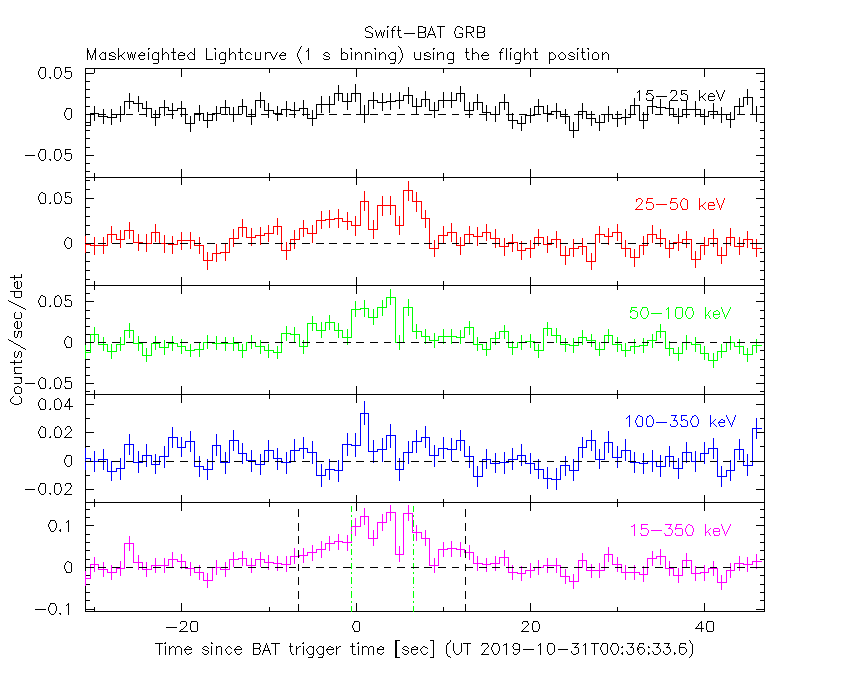
A. D'Ai (INAF-IASFPA) for the Swift team
At 00:36:33 UT, the Swift Burst Alert Telescope (BAT) triggered and located GRB 191031A (trigger=932435) (D'Ai et al. GCN Circ. 26101). Swift did not slew due to an observing constraint. At the time of the trigger, the initial BAT position was 27° from the Sun (1.3 hours East) and 33° from the 11%-illuminated Moon. Table 1 contains the best reported positions from Swift.
Table 2 is a summary of GCN Circulars about this GRB from observatories other than Swift.
Standard analysis products for this burst are available at https://gcn.gsfc.nasa.gov/swift_gnd_ana.html.
As reported by Markwardt et al. (GCN Circ. 26131),
the BAT ground-calculated position is RA, Dec = 233.490, 6.109 deg which is RA(J2000) = 1
The mask-weighted light curve (Figure 1) shows a single pulse with some overlying structure.
The emission starts at ~T-8 s, peaks at T+3 s, and decays to background by ~T+18 s.
A pre-planned spacecraft slew took the burst location out of the field of view by T+95 s.
The time-averaged spectrum from T-11.08 to T+16.87 s is best fit by a simple power-law model.
The power law index of the time-averaged spectrum is 1.38 ± 0.19.
The fluence in the 15-150 keV band is 9.0 ± 1.1 x 1
The results of the batgrbproduct analysis are available at https://gcn.gsfc.nasa.gov/notices_s/932435/BA/.
XRT refined results are not available.
UVOT results are not available.

Figure 1. The BAT
mask-weighted light curve in the four individual and total
energy bands. The units are counts
| RA (J2000) | Dec (J2000) | Error | Note | Reference |
|---|---|---|---|---|
| 1 |
+06°06'32.9" | 2.0' | BAT-refined | Markwardt et al. GCN Circ. 26131 |
| Band | Authors | GCN Circ. | Subject | Observatory | Notes |
|---|---|---|---|---|---|
| Optical | Watson et al. | 26103 | COATLI Optical Observations | COATLI | |
| Optical | Lipunov et al. | 26113 | Swift GRB191031.89: Global MASTER-Net observations report |
MASTER | |
| Gamma-ray | Fermi | 26102 | Fermi GBM Final Real-time Localization | Fermi GBM | |
| Gamma-ray | Lesage et al. | 26116 | Fermi GBM detection | Fermi GBM |
November 2, 2019